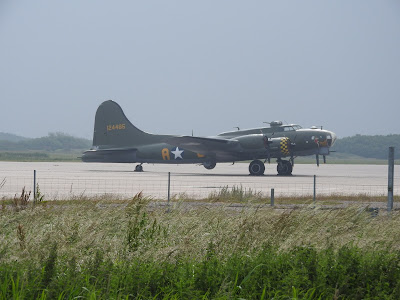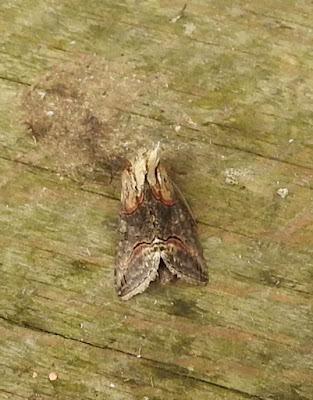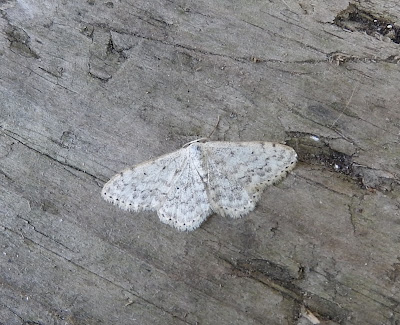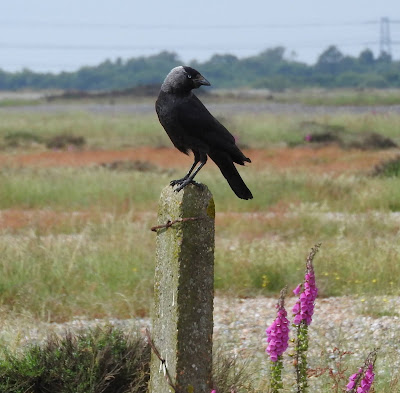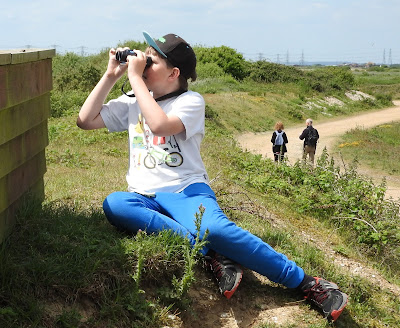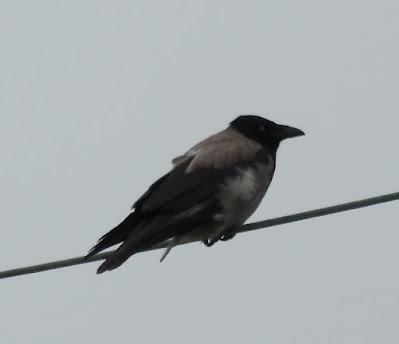Lade - muggy, overcast, rain, light airs - Another steamy wet night and morning with 18mm recorded at Littlestone yesterday by OL. The moth trap was a bit soggy but did contain 16 species, including our first Privet Hawk-moth of the summer, always a cause for celebration. A morning tour of the local patch was memorable for Cuckoos, that appeared to be having something of a last hurrah before their inevitable departure. Two males were calling at either end of the site with a female around the willow swamp, followed by another female that was loitering with intent by a small reedbed at the southern end of south lake. She spent a fair bit of time sat on an old concrete post eying up the reedbed before flopping onto what I pressume was a Reed Warbler`s nest. After a few minutes she flew out of the reeds and away carrying what appeared to be an egg having, I suppose, `done the dirty deed` in the warblers nest. She then finished off atop a willow emitting a satisfying burst of `bubbling` which seemed to suggest - "job done"! The only other noteworthy event was a huge overnight increase in Pochard numbers to 235, all on south lake.
Privet Hawk-mothMonday 28 June 2021
Sunday 27 June 2021
Returning waders
Lade - overcast, humid, rain, NE 3 - A muggy weekend of weather with sunshine yesterday and an ideal time to give Barney his summer trim-up, in contrast to today which was another wet one. It was good to see plenty more Mallards, Coots, Moorhens, Dabchicks and a Gadwall showing off their progeny across the local patch this weekend, although they had to be alert as at least three different Marsh Harriers were on the wing. One or two Common Terns fished the lake before heading back towards ARC and at least one Cuckoo vocalised from the willow swamp.
"Just the job, much cooler now!"
Kestrel sheltering from the rain
It`s that time of year when returning adult waders are on the radar, so this morning I paid a visit to Scotney where the highlights were two Green Sandpipers and a Greenshank outback, plus four Avocets and a Curlew. Corn Bunting, Yellow Wagtail, Skylark and Linnet were all noted feeding juveniles on the farm track and along fence posts, but I could find no sign of any Tree Sparrows around the farm buildings. Marsh Harrier, Kestrel, Buzzard, Cuckoo and hundreds of feral geese and swans were also present. Next stop Galloways, where more Skylarks, Meadow Pipits, Linnets, Whitethroats, Sedge Warblers and Stonechats were busily dashing about after youngsters. From Springfield Bridge the weedy field between the sewer and the road that is in a Countryside Stewardship Scheme continues to deliver breeding Skylark, Yellow Wagtail, Corn and Reed Buntings; more like this across the Marsh on marginal land would be most welcome. Finished off a soggy morning at Burrowes where a lone Common Sandpiper was the only wader present; Hobby and Great White Egret also noted from the track.
Friday 25 June 2021
Black Swan
Lade - cool and cloudy, showery, SW2 - We trudged around the local patch in a fine drizzle getting a right good soaking from the lush vegetation as all the pathways were choked with drooping grasses and bramble runners. Adult Cuckoos were still active around the willow swamp, but not for much longer I suspect as this African bird will soon depart south for warmer climes. A few Swifts dipped in and out over south lake where Pochard numbers had increased to 110 along with a handful each of Shoveler and Gadwall. On the ebb tide Curlews had also increased on the bay sands this afternoon to 132 birds. The garden moth trap continues to be poor with only 12 species this morning, but did include a Dark Spectacle (thanks to Steve G) which was new for the trap site.
Dark SpectacleBlack Swan, Hookers reedbed
A tour of the bird reserve produced the expected Glossy Ibis on ARC along with hundreds more Pochard, Gadwall, Mallard, Tufted Duck, Shoveler and Teal in eclipse plumage, scores of Swifts and hirundines over the lake, 30 Lapwings, 20 Common Terns and a Cuckoo calling from Tower Pits. On Burrowes the Common Tern colony continue to valiantly defend their nests from the neighbouring Herring Gulls, although I fear for the terns` first attempts with so many ravenous juvenile gulls to feed. The sum total of waders during the circular walk was: four Ringed Plovers (a pair on the shingle near the car park acted as though they had chicks nearby), a pair of Oystercatchers and a Green Sandpiper on the hayfields, 30 Lapwings and two Redshanks on the Dengemarsh fields. Also noted, a Black Swan, two Great White Egrets, two Marsh Harrier, Bearded Tits and a Kingfisher from the ramp;10 Teal and four Shoveler also on the hayfields.
Tuesday 22 June 2021
Reynard
Dungeness - cool and cloudy, NE 5 - Spent most of the day guiding for clients from London.The weather conditions were difficult with a buffeting wind keeping most passerines hunkered down in cover; still, at least the rain had ceased. We started at the point, where offshore several distant Gannets and a trickle of Black-headed Gulls and a Kittiwake flew by, plus 20 Common Terns at the Patch and further down the beach 20 Mediterranean Gulls loafing amongst a large gull flock. A Peregrine and a Kestrel showed particularly well on the power station and old lighthouse respectively, as did two Black Redstarts, several Meadow Pipits and a host of Linnets and Starlings bathing in puddles. Opposite Jarman`s Stock Dove and Skylark noted.
Meadow PipitSpot the Peregrine?
There it is!
On the bird reserve all the old favourites were eventually located for the guests including the `resident` Glossy Ibis on ARC, a Great White Egret on Boulderwall fields and a couple of close Marsh Harriers. The chilly air had forced down hundreds of Swifts and hirundines over ARC, where a pair of Teal and 10 Shovelers were within the massed ranks of Coot, Pochard and Tufted Duck. A dozen or so Common Terns are now settled on the ARC raft, complementing the 30 plus pairs on Burrowes where Redshank and Ringed Plover also noted. We ended up with a respectable 72 species, despite the strong wind.
Fox with Rabbit
The Red Fox is a common animal in these parts and is mostly encountered at dawn and dusk; I often see them scavenging along the tideline in the evening, but at this time of year with hungry mouths to feed they are regularly seen during the daylight hours. Today we saw four different animals across Dungeness, including a very showy one in the Boulderwall fields with prey.
Sunday 20 June 2021
Flower Power
Lade - warm, dry and sunny, N 2 - A cracking morning spent on the local patch with a cooling northerly airflow tempering the strong mid-summer sun when it did break through the cloud cover. It was one of those days to gladden the heart with an abundance of flora and fauna everywhere you looked. Here on the Dungeness NNR we are spoiled for choice as testified by the prodigious flush of plants that have recently flowered across the shingle ridges due to a combination of the recent rain and hot sunshine. A riot of colours and scents from the likes of broom, honeysuckle, stonecrop, scabious, bugloss, poppy, campion, bedstraw, mullein and trefoil support a variety of insects, including Common Blue, Small Heath, Red Admiral and Painted Lady butterflies, plus day-flying Cinnabar and Silver Y moths, all seen this morning. Stonechat, Whitethroat, Linnet, Dunnock, Starling and Sparrow were commonplace along with a few Skylarks, Meadow Pipits, Cuckoo and Kestrel, plus 26 Curlews leaving their high tide roost on the Desert. Around the willow swamp more juvenile Moorhens and Coots were on the water, while Reed Warblers busily gathered invertebrates for their nestlings. Several huge carp lunged out of the water disturbing a multitude of laughing Marsh Frogs and the post-breeding assemblage of Pochards had risen to 42, all drakes. The ponds are simply alive with damsel flies where also Black-tailed Skimmer, Four-spotted Chaser and a splendid Emperor dragonfly all noted.
White MulleinBiting Stonecrop
Common Blue
Last weekend we saw our first Green Sandpiper of the return passage on the bird reserve and when MC reported a notable eight birds on the hayfields this morning it was no surprise that two more were also present here at Lade on the margins of the willow swamp facing south lake. Green Sandpipers have a disjointed distribution down here and although a few winter across the Marsh the majority spend the colder months south of the Sahara. On their spring migrations they move north on a broad front but seem to miss us as they angle further east to their breeding grounds across Scandinavia and northern Russia; I remember seeing one sat in an old Redwing nest in Finland many years ago and thinking it was a bit unusual, until I realised it was on a clutch of eggs - a wader nesting up a tree, most odd! Anyhow, although both parents tend the young the females are the first to depart, and that is when we encounter the first returning migrants, adult females, from mid-June onwards when they take a more leisurely and westerly route back to their winter quarters.
Friday 18 June 2021
Turtle Dove
Lade - cloudy, muggy, wet, NE 3 - Another soggy day of clammy weather conditions, but that didn`t seem to deter the breeding warblers going about their business across the local patch. I spent a couple of hours concentrating on the willow swamp and north lake where it was good to see several broods each of Mallard and Coot on the water, plus one of Dabchick. Bit of a surprise was a Turtle Dove briefly perched atop the 20` dish `mirror`, my one and only record this year here, and probably a dispersing adult from elsewhere as I`m pretty sure they`re not breeding locally.
Little Ringed Plover, BurrowesViper`s Bugloss
A tour of the bird reserve in fine rain produced a smart adult male Little Ringed Plover in front of the Firth viewpoint on Burrowes and at least 31 Common Terns sitting on nests on a gull-free island opposite the VC. Across Dengemarsh the usual Marsh Harriers, three Ravens, two Great White Egrets, a Hobby, Bearded Tits, Corn Buntings and Yellow Wagtails and a count of 680 feral geese! A circuit of the range road and The Rype at Lydd checking out the Starlings drew a blank for a Rosy.
Thursday 17 June 2021
"Buzzards gotta eat, same as worms"
Lade - muggy, overcast, light airs - The recent heat wave certainly peaked in some style yesterday evening with an impressive thunder and lightening show over the bay as glowering banks of end-of-the-world type clouds rolled in from the near continent delivering a much needed dollop of rain in a short space of time (33mm recorded at Littlestone by OL). Moth trapping in the garden picked up accordingly this week, although species variety remains low with a Maiden`s Blush the best of the bunch. On the local patch Pochard numbers had increased to 26 this morning and the Cuckoos were still active. Apart from a brood of Mute Swan cygnets on the water other waterfowl fledglings have been few and far between; further sightings of Mink around the scaffold island suggest that they`re breeding on site and may be having an impact on ground nesting birds. However, there are plenty of common, resident passerines out and about or feeding fledglings along the coastal strip, which is a good job as predators are everywhere; in our garden alone I`ve witnessed a cat make off with one of `our` Blackbird fledglings, Jackdaws and Magpies robbing the nests of Collared Dove and Woodpigeon and a male Kestrel grabbing a young House Sparrow. A pair of Herring Gulls nesting on the roof of the chip shop next door had their four little darlings on show for all to see today, although not my favourite birds with their constant wailing from dawn to dusk and crapping everywhere. Still, all part of the circle of life, I suppose, and as Clint Eastwood memorably said in the best cowboy film ever, The Outlaw Josey Wales: " To hell with them fellas, buzzards gotta eat, same as worms!"
Spitfire over LadeMullein Wave
Maiden`s Blush
Jackdaw, Lade Desert
Urban terrorists on the chip shop roof!
This afternoon I spent an hour at the seawatch hide having a natter and a catch-up with Tony G. Surprisingly, considering the time of year, we had a trickle of Gannets feeding offshore, two Mediterranean Gulls at the Patch and 28 Common Scoters, eight Sandwich and a Common Tern up-Channel. On the beach opposite Jarman`s a female Wheatear busily fed two well-grown youngsters. This evening on Lade bay, as the fog rolled in to the sound of distant thunder, a mixed flock of 12 Ringed Plovers and Dunlins fed on the receding tideline before being flushed by joggers.
Dunlin and Ringed Plovers on the bay this eveningMonday 14 June 2021
A Trio of Buntings
Greatstone - hot, dry and sunny, light airs - After clearing a mediocre catch from the garden moth trap we decided on a change of scene for our early morning walk (mainly due to Barney suffering in the heat at Lade). In the shade of the copse at the end of Dunes Road, Song Thrush, Lesser Whitethroat, Blackcap and Chiffchaff were in good voice, where Great Spotted and Green Woodpeckers and a Treecreeper also noted.
Greatstone dung heapThe large, sprawling dung heap nearby on open farmland is always worth a look and today delivered a noisy flock of Starlings (no pink ones though), Pied Wagtails, Linnets and our first juvenile Yellow Wagtail of summer on the wing. House Martins and Swallows hawked insects rising off the dung as some of martins collected `mud` for their nests in the wetter patches. The surrounding arable land of Romney Salts delivered a trio of buntings: a Corn Bunting along the old railway track, a Reed Bunting singing from the middle of a field of wheat and a distant Yellowhammer over towards Belgar Farm. Kestrel, Buzzard, Whitethroat and Stock Dove also noted and on the way home the Hooded Crow was still loafing around the car park opposite the Jolly Fisherman.
Sunday 13 June 2021
The Apprentice Naturalist
Lade - hot, dry and sunny, light airs - Our apprentice naturalist was up and about early this morning to record last nights catch in the Plovers moth trap. Incredibly, he remembered some of the moth names from two years ago when he last stayed with us due to the Covid shutdown; 23 species were logged including Toadflax Brocade and Small Dusty Wave new for the year. We then checked out the Smooth Newt activity in the wildlife pond before filling up the bird feeders and having first breakfast. Afterwards we headed out to the lakes where we had good views of two Cuckoos, and a Pochard on south lake which was the first returning bird of the summer/autumn. The Cuckoos were singing off one another with the bird on the post dropping down onto the broom to collect caterpillars whilst being watched warily by a family of Starlings. Three more spikes of Bee Orchids were located as we collected a box-full of elderflower florets for his mum to make cordial when he was delivered back to Folkestone this afternoon.
Toadflax Brocade, White Spot, Shoulder-striped Wainscot and Buff-tipSaturday 12 June 2021
The Apprentice Birdwatcher
Lade - warm, dry and sunny, SW 2 - A muggy start to the day that got hotter as the sun broke through the early morning cloud. On the local patch plenty of activity on the shingle ridges with hundreds of House Sparrows, Starlings and Jackdaws feeding on invertebrates. A search for Bee Orchids in the usual spot revealed three plants, one in full flower, although there was no sign of any Southern Marsh Orchids.
Bee Orchid, Lade
Friday 11 June 2021
Hoodie and a Pratincole
Lade - cool and misty start, sunny later, SW 3 - Another murky start to the day that eventually cleared about noon once the sun broke through. After a wander around a quiet local patch it was down to Greatstone where the Hooded Crow that has been present since last weekend was slumped on an overhead power wire opposite the car park. After a while it flew off towards the sand dunes for a scavenge along the beach before settling on a post by the main track. Hoodies are only occasional visitors to the Dungeness area, normally during the spring and autumn period and rarely stick for long, so this week-long summer record is most welcome.
Greatstone Hoodie in the early morning murk
Glossy Ibis, ARC
A check of Burrowes produced a few Ringed Plovers, Redshanks and Oystercatchers and a family of Egyptian Geese being harassed by the gulls; was good to see at least 50 Common Terns on a shingle island in front of Dennis`s hide that appeared to be settling down to breed, despite a family of Herring Gulls nearby. A one hour stake out overlooking the Boulderwall fields produced the goods in the form of Great White and Little Egrets, two Hobbies, Marsh Harrier, Buzzard, Bearded Tit, a steady flow of House Martins and Swifts, a Yellow Wagtail, loads of feral geese and a post-breeding flock of 50 Lapwings. And then as the sun broke through up came the Collared Pratincole to hawk insects over Gun Club pool. Across the road the Glossy Ibis had the trashed gullery (badgers the likely culprits) to itself. News also came through of a Golden Oriole over Hookers and a Rose-coloured Starling.
Thursday 10 June 2021
Cattle Egrets
Dungeness - warm, dry and sunny, SW 3 - A decent catch of 15 species of moths in the garden trap first thing included a Small Elephant Hawk-moth and a Treble Lines. For a change of scene we had a walk around the Trapping Area this morning where the expected warblers were in good voice, plus a family party of Long-tailed Tits by the feeders and a flyover Shelduck. Back at the car park a Common Buzzard soaring overhead received the full treatment from the local male Peregrine who continually stooped on the unsuspecting buteo until it drifted off east.
Treble Lines and Small Elephant Hawk-moth
A wander around Dengemarsh produced two Cattle Egrets amongst the stock, two Great White Egrets, three Hobbies, an Avocet opposite the hide and several each of Shelduck, Redshank and Lapwing on the hayfields. There was the usual supporting cast of wildfowl, grebes, Common Terns, Marsh Harriers, Bearded Tits, Sedge and Reed Warblers, Lesser and Common Whitethroats and Reed Buntings. The Ibis was reported on ARC in its usual spot amongst the gulls.











